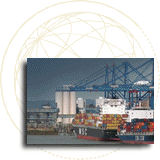
DEVELOPMENT: AID FOR TRADE
The Enhanced integrated Framework
To access Aid for Trade, developing countries must clearly prioritize their needs. In return, their development partners need to provide trade-related assistance and capacity building to meet the demand with a supply of resources. To bridge the gap between demand and supply as effectively as possible, developing countries need to mainstream their demand for Aid for Trade into their national development strategies, such as the Poverty Reduction Strategy Papers (PRSPs), since these form the platform on which donors base their aid planning.
For the least-developed countries (LDCs), the Enhanced Integrated Framework (EIF) is helping to bridge the gap between demand and supply for Aid for Trade and to mainstream trade into national development plans.
The EIF is the main mechanism through which LDCs access additional Aid for Trade resources. The EIF provides a procedure for:
-
clearly mapping out and prioritizing key needs for trade-related assistance and capacity building, including trade infrastructure, supply and productive capacity
-
submitting these demands to the donor community of each country for accessing funding beyond the resources available in the Framework's own Trust Fund.
LDCs can channel their demand for Aid for Trade through the EIF process (involving Diagnostic Trade Integration Studies). The supply of resources is coordinated through local EIF institutions, such as the EIF Focal Point, the National Implementation Unit and the Donor Facilitator.
Predictable, sustainable and effective financing is fundamental for fulfilling the Aid for Trade mandate. The EIF process not only assists LDCs in mainstreaming trade into their national development strategies but also provides LDCs with the platform for leveraging additional funding from their development partners. This allows them to translate their trade-related needs into funded and deliverable projects.
The EIF's Trust Fund is not sufficient on its own to fund many of the activities that LDCs need to boost their trade capacity. Additional funds sought through the EIF process over and above the EIF Trust Fund represent a significant proportion of Aid for Trade. The EIF therefore forms a key pillar within the much larger edifice of Aid for Trade.
Tier 1 of the EIF Trust Fund provides funding to strengthen LDCs' capacity to manage the benefits of Aid for Trade. This funding helps to incorporate trade into national development plans and to translate trade priorities into bankable projects for broader Aid for Trade funding.
The Trust Fund also supports the implementation of some of the activities identified as priorities, taking into account the availability of alternative funding and the quality of the projects. Tier 2 of the Trust Fund provides bridging funding to “jump start” activities through:
-
project preparation
-
feasibility studies
-
funding of smaller projects, including seed projects.
However, for most activities identified through the EIF, resources
for implementation have to be mobilized from other sources beyond
the EIF Trust Fund. These resources can be channelled through a
variety of means, depending on the donor's specific practices.